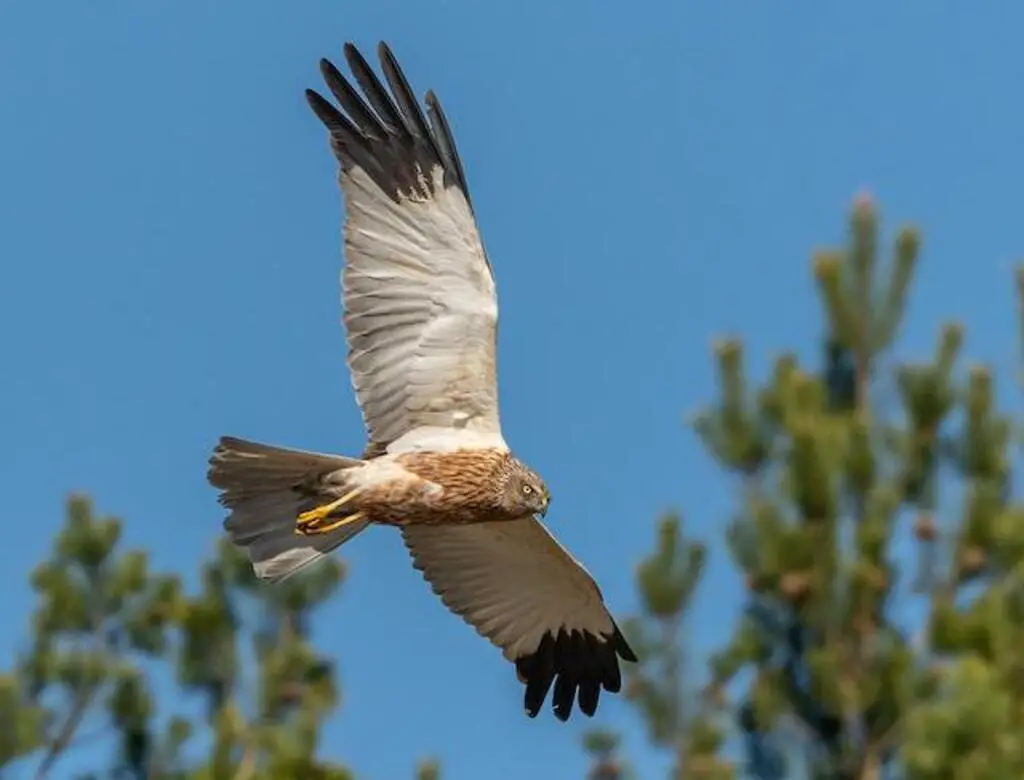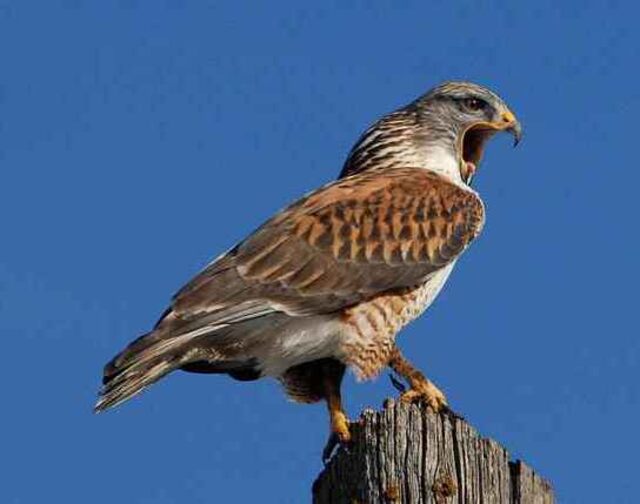What Hawks Live In The Desert? Get ready to embark on a thrilling desert expedition as we unravel the secrets of these majestic birds of prey and their extraordinary role in the desert ecosystem.
From the cooperative hunters like the Harris’s Hawk to the mighty Ferruginous Hawk, the largest of its kind in North America, our journey will unveil the unique adaptations that allow these hawks to thrive in the harsh desert environment.
Join us in this captivating article as we explore their remarkable hunting prowess, their significance as ecosystem indicators, and the delicate balance they help maintain in the desert food chain.
Brace yourself for an awe-inspiring adventure into the world of desert-dwelling hawks, where survival is a true testament to their grace and strength!
Table of Contents
- 1 Key Takeaways
- 2 What Hawks Live In The Desert?
- 3 Importance of Hawks in Desert Ecosystems
- 4 Harris’s Hawk
- 5 Red-tailed Hawk
- 6 Cooper’s Hawk
- 7 Ferruginous Hawk
- 8 Swainson’s Hawk
- 9 Northern Harrier
- 10 Frequently Asked Questions
- 10.1 What is the average lifespan of a hawk in the desert?
- 10.2 How do hawks adapt to the extreme temperatures in the desert?
- 10.3 What threats do hawks in the desert face from human activities?
- 10.4 How do hawks in the desert differ from those in other environments?
- 10.5 Are there any endangered species of hawks in the desert?
- 11 Conclusion
- 12 Author
Key Takeaways
- Desert hawks have developed adaptations to make their long-distance migration more successful.
- Hawks in the desert hunt a variety of animals, sometimes in groups, and have a variety of hunting techniques.
- Northern Harrier is a diurnal raptor species commonly found in desert habitats.
- Conservation efforts involve habitat restoration and protection, monitoring and research, and public education and outreach.
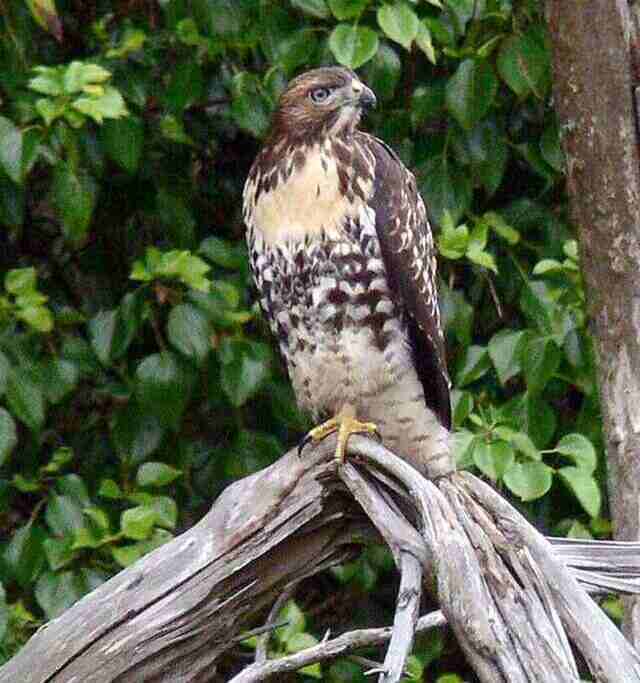
What Hawks Live In The Desert?
Several hawk species thrive in the desert. Notable examples include the Harris’s Hawk, known for its cooperative hunting behavior, and the Ferruginous Hawk, North America’s largest hawk.
These birds have adapted to the harsh desert environment, playing vital roles in the ecosystem by preying on various creatures and helping maintain balance.
Importance of Hawks in Desert Ecosystems
Hawks play a crucial role in desert ecosystems by regulating prey populations and maintaining a balance of species diversity. The importance of predator-prey relationships cannot be overstated in any ecosystem, and the desert is no exception.
Hawks help control rodent populations, which can quickly multiply and cause damage to vegetation and other animals.
By keeping these populations in check, hawks prevent the spread of disease and ensure that other species have access to resources.
One particular species of hawk, the Harris’s hawk, is a social bird that works together with other Harris’s hawks to hunt prey.
This unique behavior has made them an important symbol of the desert and a fascinating subject for research.
Understanding the role of hawks in desert ecosystems is critical to maintaining the health and balance of the environment.
Harris’s Hawk
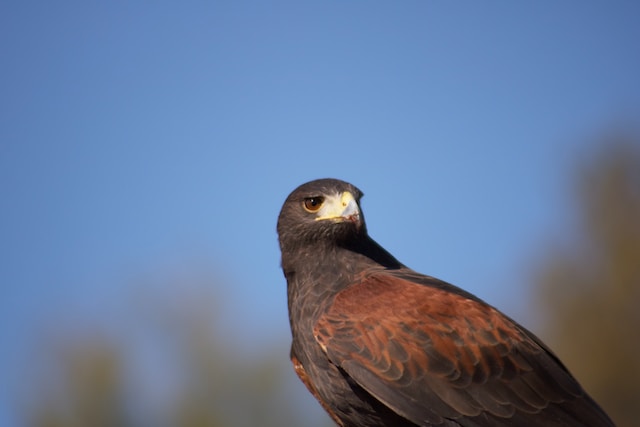
The Harris’s hawk is a notable bird of prey found in arid regions, with a range that extends from the southwestern United States to South America.
This species is known for its unique behavioral patterns, as it is one of the few raptors that hunt cooperatively in groups.
Harris’s hawks have a diverse diet, including small mammals, birds, reptiles, and insects.
Their habitat preferences include desert scrub, riparian areas, and agricultural fields.
Interestingly, they are known to be highly intelligent and have been trained for falconry for centuries.
Overall, the Harris’s hawk plays an important role in regulating prey populations in desert ecosystems.
Moving forward, let’s explore the characteristics of the red-tailed hawk.
Red-tailed Hawk
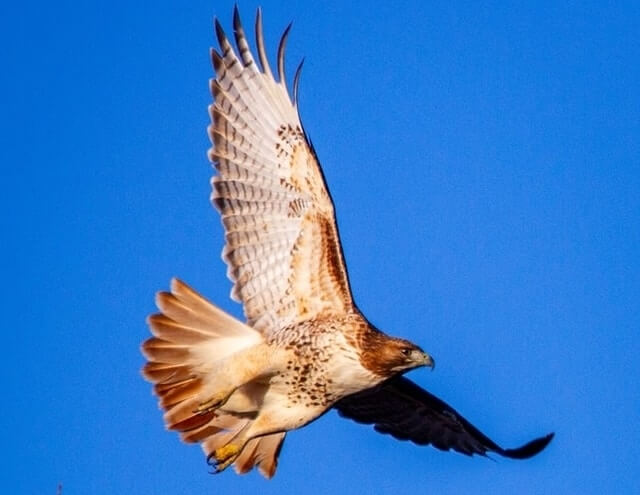
Found throughout North America, the red-tailed hawk is a large bird of prey known for its distinctive rust-colored tail feathers and broad wingspan.
These birds prefer habitats with open fields and meadows, but can also be found in deserts, mountains, and forests.
Their physical characteristics include sharp talons, a hooked beak, and keen eyesight, making them adept at hunting small mammals, birds, and reptiles.
With a wingspan of up to four feet, they are able to soar high above their territory, surveying the land for prey.
Despite their size and strength, red-tailed hawks face threats from habitat loss, pesticides, and collisions with vehicles.
As we move into the section on Cooper’s hawk, we’ll explore how this species differs from its desert-dwelling counterpart.
Cooper’s Hawk

The Cooper’s Hawk is a medium-sized bird of prey that is known for its ability to hunt in urban areas.
These birds are also known for their unique migratory patterns, with some populations staying in one area year-round while others migrate long distances.
Despite their adaptability and widespread presence, conservation concerns have been raised over the years due to habitat loss and human interference.
Hunting in urban areas
Hunting in urban areas is a challenge for hawks due to the presence of buildings and other man-made structures. However, some hawks have adapted to urban environments by altering their hunting strategies and prey selection.
The Cooper’s Hawk, for instance, has been observed preying on smaller birds that are common in urban areas.
Other hawks, such as the Red-tailed Hawk and the Harris’s Hawk, have been known to hunt in open spaces within cities, such as parks or golf courses.
Some hawks have also been seen perching on telephone poles or streetlights to gain a better vantage point.
Despite these adaptations, urban environments still pose a threat to hawks, as they are at risk of colliding with buildings or being exposed to environmental toxins.
Understanding how hawks have adapted to urban environments can help us better protect these birds of prey and ensure their survival in the face of human development.
As these hawks navigate through urban areas, they may also experience changes in their migratory patterns, which will be discussed in the next section.
Migratory patterns
Understanding the migratory patterns of hawks is crucial for their survival and conservation, as changes in these patterns can have significant impacts on their population and distribution.
Hawk populations can be influenced by various factors such as prey availability, weather conditions, and habitat changes, which can cause seasonal changes in their migratory patterns.
For example, some hawks may travel thousands of miles from their breeding grounds in the Arctic to their wintering grounds in the desert.
These migratory patterns are essential for the survival of the hawks, as they allow them to access different habitats and resources throughout the year.
However, changes in these patterns can have significant impacts on their population, such as reducing their breeding success, increasing their mortality rates, and altering their distribution.
Therefore, understanding and monitoring these migratory patterns is crucial for the conservation of hawks and their habitats.
Conservation concerns include the protection of key habitats along their migration routes, reducing human disturbances, and mitigating the impacts of climate change.
Conservation concerns
One major challenge facing the conservation of migratory raptors is the degradation and loss of critical stopover sites, which can result in a catastrophic decline in their population size.
The conservation challenges facing hawks living in the desert are immense, as the arid ecosystem is already under threat due to human activities such as mining, oil and gas exploration, and agricultural expansion.
Habitat loss has a direct impact on the hawks, as it reduces their available food sources and nesting sites.
Moreover, illegal hunting, poisoning, and collisions with power lines and wind turbines also pose a significant threat to their survival.
To combat these challenges, conservationists are working to identify and preserve critical habitats, establish protected areas, and implement measures to reduce the impact of human activities on the hawk populations.
However, the success of these efforts depends on the cooperation and support of local communities and policymakers.
Without their involvement, it will be difficult to ensure the long-term survival of these magnificent birds in the desert.
Transitioning into the subsequent section, the ferruginous hawk is a species that has been greatly affected by these conservation challenges.
Ferruginous Hawk
The Ferruginous Hawk (Buteo regalis) is a large bird of prey that inhabits arid and semi-arid regions of the Western Hemisphere.
This species is known for its impressive size, with a wingspan that can reach up to 4 feet.
Physical characteristics include a rusty-red plumage on the back and wings, a white underbelly, and distinctive dark patches around the eyes.
The Ferruginous Hawk is known for its nesting behavior, building nests that are typically located on cliffs or in tall trees.
Females lay 2-4 eggs, which are incubated for approximately 32 days. Once hatched, the chicks are cared for by both parents and fledge after about 7-8 weeks.
Despite being a formidable predator, the Ferruginous Hawk faces conservation concerns due to habitat loss and degradation, as well as persecution by humans.
Transitioning to the subsequent section, the Swainson’s Hawk is also a bird of prey that can be found in desert habitats.
Swainson’s Hawk
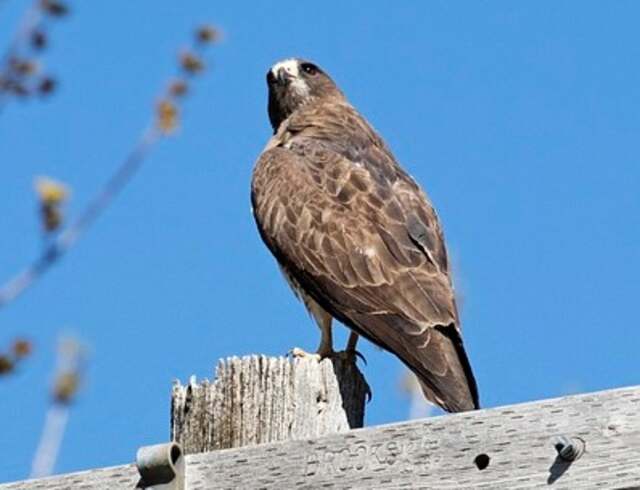
The Swainson’s Hawk (Buteo swainsoni) is a majestic bird of prey that is known for its long-distance migration. These hawks breed in North America and then migrate to South America for the winter, traveling over 6,000 miles each way.
Their diet consists mainly of small mammals, birds, reptiles, and insects, and they are known to hunt both from the air and from the ground.
Due to habitat loss and pesticide use, the Swainson’s Hawk has declined in numbers in some areas, and conservation efforts are being made to protect their breeding and wintering grounds.
Long-distance migration
Long-distance migration is a challenging task for desert hawks, as they must navigate unpredictable weather patterns and find suitable food sources along their route.
Challenges faced during long distance migration include the need to conserve energy while flying long distances, avoiding predators, and finding adequate food sources.
To adapt, desert hawks have developed a number of physiological and behavioral adaptations to make their long journeys more successful.
For example, they are able to slow down their metabolism and enter a state of torpor during periods of food scarcity, which helps them conserve energy.
They are also able to navigate using a variety of cues, including the position of the sun and stars, as well as visual landmarks on the ground.
The effect of climate change on long distance migration of desert hawks is not yet fully understood, but it is thought that changes in weather patterns and the availability of food sources could have a significant impact on their ability to migrate successfully.
Overall, the ability of desert hawks to complete their long journeys is a testament to their resilience and adaptability in the face of challenging conditions.
As we explore their diet and feeding habits, we will see how these adaptations also influence their feeding strategies.
Diet and feeding habits
Long-distance migration is a common trait among many species of hawks, allowing them to follow the seasonal patterns of their prey.
Speaking of prey, it is worth exploring the diet and feeding habits of desert hawks.
These birds of prey are known to hunt a variety of animals, including lizards, snakes, rodents, and birds.
Some species, like the Harris’s hawk, are even known to hunt in groups, using coordinated attacks to take down larger prey.
Hawks have a variety of hunting techniques, including soaring at high altitudes to scan the terrain below, or perching in elevated positions to wait for prey to pass by.
The types of prey and hunting techniques used by desert hawks vary depending on the species, but one thing remains constant: their vital role in maintaining the delicate balance of desert ecosystems.
Speaking of which, let’s now turn our attention to the conservation efforts aimed at protecting these fascinating birds.
Conservation efforts
Conservation efforts for these impressive raptors have been implemented in various regions, with the aim of protecting their habitats and ensuring their survival.
In the desert habitat, where many hawks reside, there are several initiatives that have been put in place to protect these endangered species.
These efforts include habitat restoration and protection, monitoring and research, and public education and outreach.
Habitat restoration and protection involve preserving and restoring the natural environment where hawks live, which includes reducing human impacts such as land development and pollution.
Monitoring and research help to gather information about hawks, their habitat, and their behavior, which can be used to inform conservation efforts.
Public education and outreach aim to increase awareness and understanding of the importance of hawks and their role in the ecosystem, as well as promoting responsible behavior around these birds.
These initiatives are crucial for the survival of hawks in the desert habitat, and they serve as a reminder of the importance of conservation efforts for all endangered species.
The next section will focus on the northern harrier and its unique characteristics.
Northern Harrier

The Northern Harrier, a diurnal raptor species, is commonly found in desert habitats. This species is known for its distinctive hunting techniques, which include low-level flight over open areas and hovering over prey.
Northern Harriers have keen senses of hearing and sight, which enable them to locate prey such as small mammals and birds.
They have a distinctive facial disc that aids in sound localization, and their wings are uniquely shaped for agile flight.
Their habitat in the desert is often characterized by open areas with low vegetation, such as grasslands and marshes.
The Northern Harrier plays an important role in the ecosystem as a predator and can help control populations of small mammals and birds.
Appreciating the diversity of hawks in the desert is important for understanding the complex relationships between species in this unique environment.
Frequently Asked Questions
What is the average lifespan of a hawk in the desert?
The average lifespan of hawks in the desert can vary due to factors affecting longevity, such as food availability and predation. Breeding patterns can also impact lifespan. Further research is needed to determine specific lifespan averages for desert hawks.
How do hawks adapt to the extreme temperatures in the desert?
Hawks in the desert have developed adaptation strategies to cope with extreme temperatures. They employ hunting techniques that minimize energy expenditure, such as soaring on thermals, and exhibit physiological adaptations, including panting and reducing metabolic rate, to survive in the harsh environment.
What threats do hawks in the desert face from human activities?
Hawks in the desert face threats from human activities such as habitat destruction, hunting, and poisoning. Conservation efforts are necessary to mitigate these impacts and ensure the survival of these majestic birds.
How do hawks in the desert differ from those in other environments?
Desert hawk behavior and hunting techniques differ from those in other environments due to the arid and sparse landscape. They have adapted by utilizing opportunistic feeding habits and relying on their keen eyesight to locate prey.
Are there any endangered species of hawks in the desert?
Conservation efforts for hawks in the desert are crucial as some species such as the Ferruginous hawk and the Northern harrier are threatened by habitat loss. Effective conservation measures are needed to protect these species and their habitats.
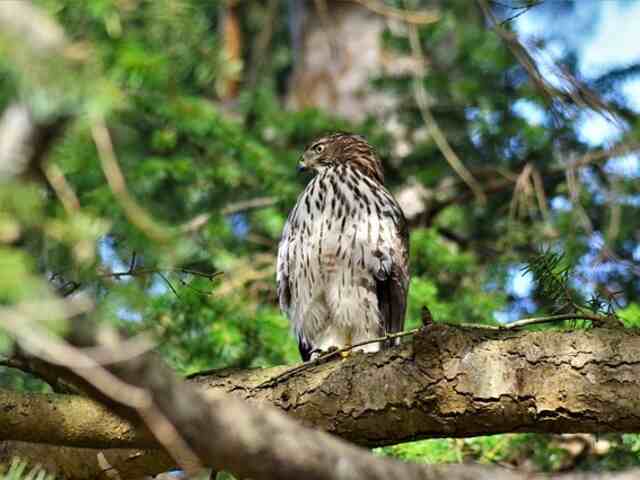
Conclusion
Hawks play a crucial role in desert ecosystems by controlling rodent populations and maintaining balance in their respective food chains.
Several species of hawks inhabit the desert, each with unique characteristics and adaptations to survive in this harsh environment.
The Harris’s Hawk is a social hawk that lives in groups and is known for its cooperation in hunting. The Red-tailed Hawk is a solitary predator with exceptional vision and is often seen perched atop tall cacti.
The Cooper’s Hawk is a fast and agile bird that preys on small birds and mammals, while the Ferruginous Hawk is the largest hawk in North America, capable of taking down prey as large as jackrabbits.
The Swainson’s Hawk migrates to the desert in the summer months and feeds on insects and small mammals.
The Northern Harrier, also known as the marsh hawk, is a low-flying bird that hunts over open areas and feeds on small mammals, birds, and reptiles.
By appreciating the diversity of hawks in the desert, we can better understand and protect these important species and their roles in maintaining the delicate balance of desert ecosystems.
It is crucial to preserve these habitats and the diversity of species that call them home.
To emphasize this point, consider the following table:
| Hawk Species | Habitat | Unique Adaptations |
|---|---|---|
| Red-tailed Hawk | Desert scrubland | Sharp talons for hunting small mammals |
| Cooper’s Hawk | Desert riparian areas | Agile flight for chasing prey through trees |
| Harris’s Hawk | Desert grasslands | Cooperative hunting in groups |
In conclusion, the variety of hawks in the desert highlights the resilience and adaptability of these magnificent birds of prey.
As the saying goes, ‘birds of a feather flock together,’ and in the case of the Harris’s Hawk, this idiom rings true as they work together to hunt and survive in the harsh desert environment.
By studying and protecting these important species, we can ensure the continued health and balance of desert ecosystems for generations to come.

